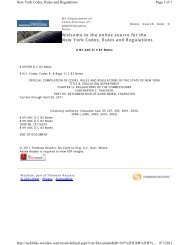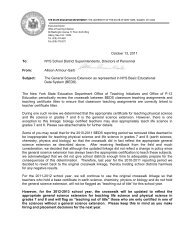ESL Learning Standards - Higher Ed - New York State Education ...
ESL Learning Standards - Higher Ed - New York State Education ...
ESL Learning Standards - Higher Ed - New York State Education ...
Create successful ePaper yourself
Turn your PDF publications into a flip-book with our unique Google optimized e-Paper software.
Intermediate (5 – 8) Commencement (9 – 12)<br />
9. Convey and organize information, using facts, details,<br />
illustrative examples, and a variety of patterns and<br />
structures.<br />
Such patterns and structures include chronological<br />
order, cause and effect, problem and solution, and general-to-specific<br />
presentation. (S, W)<br />
9. Convey and organize information, using facts, details,<br />
illustrative examples, and a variety of patterns and<br />
structures. Such patterns and structures include chronological<br />
order, cause and effect, problem and solution,<br />
and general-to-specific presentation.<br />
(S, W)<br />
<strong>ESL</strong><br />
1<br />
10. Distinguish between fact and opinion, and relevant and<br />
irrelevant information, and exclude nonessential information<br />
in oral and written presentations. (S, W)<br />
11. Use the process of prewriting, drafting, revising, peer<br />
editing, and proofreading (the “writing process”) to produce<br />
well-constructed informational texts.<br />
(L, S, R, W)<br />
12. Convey information and ideas through spoken and<br />
written language, using conventions and features of<br />
American English appropriate to audience and purpose.<br />
Such spoken language features include appropriate<br />
grammar, vocabulary, pronunciation, intonation, and a<br />
wide variety of sentence structures.<br />
Such written language features include appropriate<br />
grammar, vocabulary, correct spelling, punctuation, capitalization,<br />
paragraphing, and a wide variety of sentence<br />
structures. (L, S, R, W)<br />
10. Distinguish between fact and opinion, and relevant and<br />
irrelevant information, and exclude nonessential information<br />
in oral and written presentations. (S, W)<br />
11. Use the process of prewriting, drafting, revising, peer<br />
editing, and proofreading (the “writing process”) to produce<br />
well-constructed informational texts.<br />
(L, S, R, W)<br />
12. Convey information and ideas through spoken and<br />
written language, using conventions and features of<br />
American English appropriate to audience and purpose.<br />
Such spoken language features include appropriate<br />
grammar, vocabulary, pronunciation, and intonation.<br />
Such written language features include appropriate<br />
grammar, vocabulary, correct spelling, punctuation, capitalization,<br />
paragraphing, and a wide variety of sentence<br />
structures. (L, S, R, W)<br />
PERFORMANCE<br />
INDICATORS<br />
13. Engage in collaborative activities through a variety of<br />
student groupings to read, gather, share, discuss, interpret,<br />
organize, analyze, and present information. Such<br />
groupings include small groups, cooperative learning<br />
groups, process writing groups, cross-age groupings,<br />
research groups, and interest groups.<br />
(L, S, R, W)<br />
14. Consult print and nonprint resources (e.g., audio/visual<br />
media, family) in the native language when needed.<br />
(L, S, R)<br />
15. Apply self-monitoring and self-correcting strategies for<br />
accurate language production and oral and written presentation,<br />
using established criteria for effective presentation<br />
of information. (L, S, R, W)<br />
13. Engage in collaborative activities through a variety of<br />
student groupings to read, gather, share, discuss, interpret,<br />
organize, analyze, synthesize, and present information.<br />
Such groupings include small groups, cooperative<br />
learning groups, process writing groups, cross-age<br />
groupings, research groups, and interest groups.<br />
(L, S, R, W)<br />
14. Consult print and nonprint resources (e.g., audio/visual<br />
media, family) in the native language when needed.<br />
(L, S, R)<br />
15. Apply self-monitoring and self-correcting strategies for<br />
accurate language production and oral and written presentation,<br />
using established criteria for effective presentation<br />
of information. (L, S, R, W)<br />
16. Apply learning strategies to acquire information and<br />
make texts comprehensible and meaningful.<br />
Such strategies include using prior knowledge, graphic<br />
organizers, and context cues; planning; note taking;<br />
inferencing; questioning; exploring cognates and root<br />
words; and applying ideas to new settings or experiences.<br />
(L, S, R, W)<br />
16. Apply learning strategies to acquire information and<br />
make texts comprehensible and meaningful.<br />
Such strategies include using prior knowledge, graphic<br />
organizers, reference materials, and context cues; planning;<br />
note taking; questioning; exploring cognates and<br />
root words; and applying ideas to new settings or experiences.<br />
(L, S, R, W)<br />
Performance Indicators<br />
by Grade Level 15
















